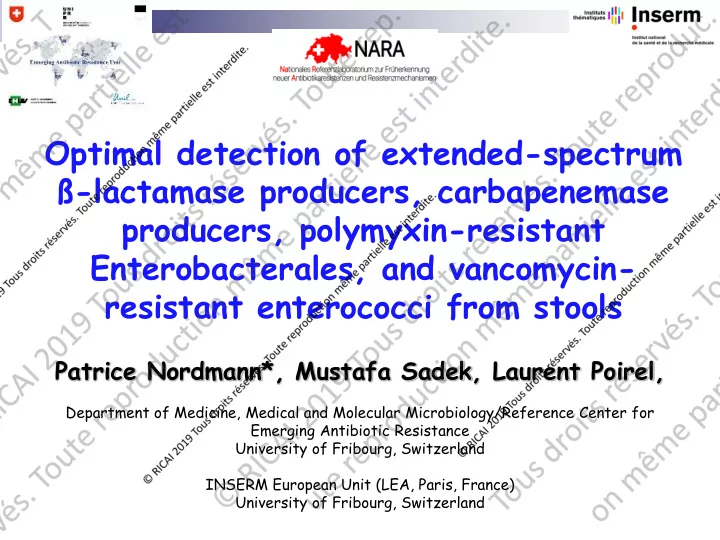

Optimal detection of extended-spectrum ß-lactamase producers, carbapenemase producers, polymyxin-resistant Enterobacterales, and vancomycin- resistant enterococci from stools Patrice Nordmann*, Mustafa Sadek, Laurent Poirel, Department of Medicine, Medical and Molecular Microbiology/Reference Center for Emerging Antibiotic Resistance University of Fribourg, Switzerland INSERM European Unit (LEA, Paris, France) University of Fribourg, Switzerland
Introduction ❖ The early detection of multidrug-resistant (MDR) bacteria in colonized patients is becoming crucial for the prompt implementation of optimal infection control strategies ❖ It is clear that the use of chromogenic and antibiotic- containing media is useful for improving the identification and recovery of MDR bacteria from stool samples ❖ However, the use of an enrichment step for their detection is not a common practice and the added-value of this approach remains unclear
Among the main issues nowadays … ❖ ESBL producers considering that gastro-intestinal colonization with ESBL-E is associated with an increased risk of bacteremia ❖ Carbapenemases since the detection of carbapenemase-producing Enterobacterales (CPE) is challenging with a level of resistance to carbapenems varying depending on the nature of the carbapenemase, the level of expression of the corresponding gene, and the background of the strain
Among the main issues nowadays … ❖ Colistin, since polymyxins are now considered last- resort antibiotics against MDR Enterobacterales in regions endemic for CPE, such as Italy and Greece, and polymyxin-resistant Enterobacterales (PMR-E) are increasingly reported ❖ Vancomycin, with a current and sometimes undetected spread of vancomycin-resistant enterococci (VRE)
Objectives • The aim of our study was to determine whether an enrichment step, with and without antibiotics, prior to inoculation on selective agar plates increased the sensitivity of MDR screening • Our evaluation of different screening strategies focused on four clinically-relevant MDR bacteria, i.e. VRE, ESBL-E, CPE, and PMR-E
Material ❑ Our aim was to determine whether an enrichment step, with and without antibiotics, prior to inoculation on selective agar plates increased the sensitivity of MDR screening from spiked stools ❑ The evaluation of different screening strategies focused on the most clinically-relevant MDR bacteria ➢ Extended- spectrum β -lactamase producing Enterobacterales (ESBL-E) ➢ Carbapenemase-producing Enterobacterales (CPE) ➢ Polymyxin-resistant Enterobacterales (PMR-E) ➢ Vancomycin-resistant enterococci (VRE)
Methods -1 ❑ For all the enrichment strategies, two procedures were compared, namely; ➢ A 18 h-enrichment step in tryptic soy broth (TSB) without antibiotic supplementation ➢ An enrichment step using broth containing a given concentration of antibiotic - Cefotaxime (0.1-0.5 mg/L) - Ertapenem (0.1-0.5 mg/L) - Colistin (0.5-2 mg/L) - Vancomycin (1-3 mg/L)
Methods -2 ❑ Different commercially available selective agar plates was used including ➢ ChromID ESBL agar (bioMérieux) ➢ SuperCarba agar (CHROMAgar , Paris, ) ➢ SuperPolymyxin agar (ELITech Microbiology, France) ➢ ChromID VRE agar (bioMérieux).
Optimal detection of extended-spectrum ß- lactamase producers from stools (example) Spiked faecal (100 μl of ESBL-E bacterial dilutions + 900 μl of stool sample suspension) chromID ESBL agar 5 ml of TSB with 5 ml of TSB with 100 μl of the stool suspension spiked with 5 ml of tryptic soy cefotaxime (0.5 cefotaxime (0.1 ESBL-E broth (TSB) µg/ml). µg/ml). Agar plates and enrichment broths were incubated overnight at 37C chromID ESBL agar chromID ESBL agar chromID ESBL agar Colony forming units were counted after 18 h of incubation at 37C
Optimal detection of extended-spectrum ß- lactamase producers from stools (example) Spiked faecal (100 μl of ESBL-E bacterial dilutions + 900 μl of stool sample suspension) chromID ESBL agar 5 ml of TSB with 5 ml of TSB with 100 μl of the stool suspension spiked with 5 ml of tryptic soy cefotaxime (0.5 cefotaxime (0.1 ESBL-E broth (TSB) µg/ml). µg/ml). Agar plates and enrichment broths were incubated overnight at 37C • For CPE, a similar procedure with using SuperCarba agar and ertapenem (0.1 and 0.5 µg/ml) • For PMR-E, using SuperPolymyxin agar and colistin (0.5 and 2 µg/ml) • For VRE, using ChromID VRE chromID ESBL agar chromID ESBL agar chromID ESBL agar agar and vancomycin (1 and 3 µg/ml) Colony forming units were counted after 18 h of incubation at 37C
Results ❑ The impact of direct plating, non-selective broth enrichment, and selective broth enrichment for the detection of tested MDR bacteria revealed remarkable differences ❑ Following TSB enrichment, the detection of ESBL-E, CPE, PMR-E, and VRE was significantly improved when compared to direct plating on selective medium (p > 0.05) ❑ Furthermore, the use of selective enrichment containing different antibiotics - regardless of the concentration used and the type of resistance mechanism- further improved the detection of ESBL-E, CPE, PMR-E compared to non-selective enrichment step (p > 0.05), respectively supplemented with cefotaxime (0.1 mg/L), ertapenem (0.1 mg/L), colistin (0.5 mg/L)
Evaluation of direct plating on SUPERCARBA agar of spiked stools, with and without a 18 h enrichment step in TSB and in TSB+ ertapenem (ETP) at 0.1 µg/ml for the detection of CPE, as an example
Conclusion ❑ To our knowledge, this is the first study evaluating the impact of direct plating, broth enrichment, and selective broth enrichment for an optimal recovery of MDR bacteria and in particulr PMR-E. In a context of growing polymyxin resistance worldwide, this detection strategy may be clinically significant ❑ Such enrichment strategy shall be recommended to screen for MDR bacteria
Recommend
More recommend